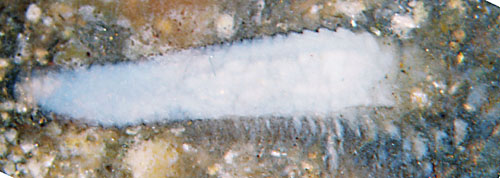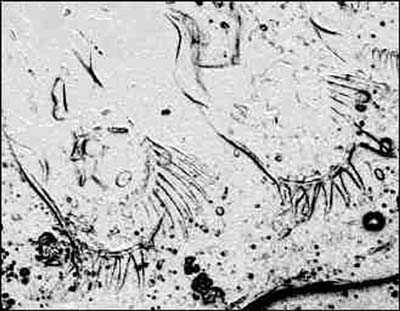Close look at Castracollis
More samples of Rhynie chert found in the latter years with the
lately discovered crustacean Castracollis
[1] allow us to gather
additional structural information which possibly will complement or
modify the reconstruction offered in [1]. (See also Rhynie
Chert News 24
.) A few polished chert slabs are presently being investigated
at the university of Ulm, Germany. Castracollis
is easily recognized by
its moults with more than 30 segments (Fig.1). Nevertheless it seems to
have been overlooked for decades.

Fig.1: Castracollis
moult, head and tail missing or hidden in the
depth.
Note
the leg size decreasing towards the rear.
Width of the
picture 4mm.
As known from other small shrimp-like creatures, many of the segments
bear legs, which come in several varieties adapted to the various
purposes they are used for (Fig.2). Some are used for paddling with the
aim to move the water or to propell the body, or both.

Fig.2: Two "feet" of a paddle-shaped type of legs selected from the
various leg types of Castracollis.
Detail extracted from a 3D-picture by J. Haug ,
Ulm.
The claws at the very end of the legs in Fig.2 and the
row of slender bristles attached sideways indicate a use as
dual-purpose devices.
It may be irrelevant here but nevertheless
interesting that Fig.1 is taken from a chert sample lacking the usual
"Higher Plant" debris but harbouring the very rare "Lower Plant"
Nematoplexus.
(See Rhynie
Chert News 29
.)
H.-J. Weiss
2009
[1] S.R.
Fayers, N.H. Trewin : A new crustacean from the Early
Devonian Rhynie Chert ...
Trans. Roy. Soc. Edinburgh, Earth Sci.
93(2003): 355-382.
 |
 |
34 |





